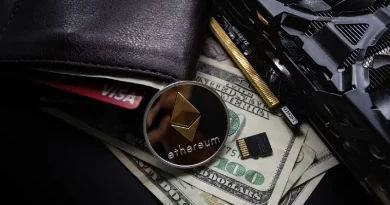Explore Cross-Chain & Interoperability Protocols
Blockchain technology has grown fast, but 70% of projects face a big problem. They work alone, not together, because they have different rules. This makes it hard for assets and data to move between networks like Ethereum and Solana.
Now, cross-chain interoperability protocols are changing this. Tools like Polkadot’s IBC and Cosmos’s Cosmos Hub help transactions move between networks. This opens up $500 billion+ in crypto assets and lets DeFi apps grow beyond their own blockchains. Today, over 30% of crypto transfers use these bridges, showing people want easy connections.
More than 80% of decentralized exchanges now use cross-chain features. The market is expected to grow 23.1% every year until 2030. This means faster trades, lower fees, and a single place where all digital assets can meet.
Key Takeaways
- 70% of blockchain projects are developing Cross-Chain and Interoperability Protocols to overcome fragmentation.
- Cross-chain bridges now handle over 30% of global cryptocurrency transactions.
- Polkadot and Cosmos lead with user growth exceeding 200% yearly through shared security models.
- Blockchain interoperability could unlock $500 billion in stranded assets by enabling cross-chain asset swaps.
- Security audits like those for the Rainbow Bridge have cut risks by addressing 90% of prior vulnerabilities.
Understanding Cross-Chain and Interoperability Protocols
Today, decentralized networks face a big challenge. Most blockchains work alone. Interoperability solutions aim to fix this by making data and assets move between networks.
At its heart, interoperability removes barriers. It helps different ecosystems work together.
Definition and Core Concepts
Interoperability protocols help networks talk to each other. The CCIP framework is a great example. It lets developers create cross-chain tokens in minutes.
These solutions use messaging systems like Axelar and Hyperlane. They move data safely and flexibly, without moving assets directly.
The Evolution of Blockchain Interoperability
- Early blockchains like Bitcoin and Ethereum worked alone, limiting asset flow.
- Now, with ERC-7683 adopted by 40+ projects, the industry is coming together.
- Protocols focus on defense-in-depth security to make cross-chain deals safer.
Why Interoperability Matters in Web3
With over 1,000 blockchain networks and $118B in DeFi TVL, we face a big problem. Interoperability solutions can unlock $67.52B on Ethereum alone. They make DeFi, NFT transfers, and business integrations easier.
For users, this means more access to liquidity and lower fees. Interoperability is more than a technical fix. It’s a key to unlocking Web3’s full power.
The Problem of Blockchain Siloes
Today, blockchain networks act like separate islands. Bitcoin, Ethereum, and Solana each have their own systems and rules. This separation comes from their design: decentralized networks focus on security but make connections hard.
Transactions on one chain can’t directly impact another. This makes moving assets and sharing data a big challenge.
“The notion of chain interoperability has seen much theory and little practice.” — Vitalik Buterin, 2016
Let’s look at some facts:
– More than 70 blockchains use cross-bridge solutions like Multichain, but many are not connected.
– Moving Bitcoin to Ethereum requires wrapped tokens, making things more complicated.
– DApps on different chains can’t work together, slowing down DeFi and NFT growth.
– Different programming languages (like Rust vs. Solidity) make technical barriers even higher.
These silos cause real problems. Users have to manage many wallets; developers must create tools for each chain. The Ronin bridge hack, which lost $625M, showed the dangers of centralized bridges.
Without blockchain interoperability, the crypto world is stuck. It can’t grow in areas like healthcare, finance, and more.
Even with growth in cross-chain protocols like Polkadot’s XCM, the industry faces big challenges. Solving these problems isn’t just about tech. It’s about finding ways for decentralized networks to work together without losing their core values.
How Cross-Chain Technology Works
Blockchain interoperability uses standardized protocols for cross-chain transactions and data exchange. Cross-chain communication happens through bridges that connect different networks. These bridges ensure assets and messages move safely between systems like Bitcoin, Ethereum, and others.
There are three main methods in cross-chain systems:
- Message passing: Direct data transfer between chains
- State verification: Confirming transaction validity across networks
- Asset representation: Minting equivalent tokens on destination chains
Consensus Mechanisms Across Chains
Interoperability needs to match different consensus models. For example:
| Blockchain | Consensus Type | Cross-Chain Compatibility |
|---|---|---|
| Bitcoin | Proof-of-Work | Relies on external oracles for validation |
| Ethereum | Proof-of-Stake | Native support through Layer-2 bridges |
| Solana | Proof-of-History | Uses validator networks for cross-chain attestation |
Security Considerations
Cross-chain transactions have unique risks. Major breaches have shown these risks:
- Ronin bridge hack ($620M loss) exposed centralized validator vulnerabilities
- Wormhole exploit ($325M loss) revealed smart contract flaws
New solutions like Chainlink’s Off-Chain Reporting protocol have secured billions in cross-chain transactions. The Cross-Chain Interoperability Protocol (CCIP) standardizes communication and reduces trust needs. Developers focus on zero-knowledge proofs and multi-signature validation to strengthen cross-chain infrastructure.
Major Cross-Chain Communication Models

Interoperability solutions use different frameworks for cross-chain communication and to improve blockchain scalability. Each model focuses on security, efficiency, and decentralization in its own way.
- Sidechains and Relays: These secondary chains link to mainnets with two-way pegs. Bitcoin’s RSK and Ethereum’s Polygon use relays for transaction validation. This method helps reduce mainnet congestion, boosting blockchain scalability while keeping security high with cryptographic proofs.
- Hash-Time-Locked Contracts (HTLCs): HTLCs make trustless atomic swaps possible with time-bound locks. They are used in decentralized exchanges like Loopring. This ensures funds are only released when conditions are met, reducing risk.
- Notary Schemes: Federated groups of validators check transactions across chains. Polkadot’s parachain auctions rely on this model, with 50% of governance decisions voted on by the community. Though fast, it requires careful validator selection to avoid centralization risks.
- Blockchain of Blockchains: Protocols like Cosmos and Polkadot create meta-architectures for chain interoperability. Polkadot’s relay chain manages consensus for up to 100 parachains. Cosmos’s IBC protocol achieves sub-5-second latency for asset transfers.
These models tackle key challenges like finality risks and liquidity management. For example, Chainlink’s CCIP uses lock-and-mint mechanics to ensure token supply integrity across 7 major chains. Despite advancements, vulnerabilities remain: over $2.5B in bridge-related hacks highlight the need for strong security. As interoperability solutions evolve, they’re expected to make up 25% of blockchain transactions by 2025, changing Web3 ecosystems.
Leading Interoperability Solutions in the Market
Interoperability solutions like Axelar, LayerZero, and Wormhole are leading the way. They make it possible for assets to move easily between different blockchain networks. This includes networks like Ethereum, Solana, and BNB Chain.
- Axelar Network processed $8.66B in cross-chain transfers, supporting 64 blockchains via 75 validator nodes.
- LayerZero’s 30 decentralized verification networks (DVNs) secure cross-chain data without shared consensus.
- Wormhole bridges assets across 30+ chains using 19 Guardian nodes, handling $10B+ in transfers.
Multi-chain applications are showing great promise. For example, Aave’s cross-chain lending and THORChain’s decentralized exchanges are making waves. Walmart uses Hyperledger for supply chain tracking, and 1inch aggregates liquidity for cross-chain orders.
But, there are challenges. Over $2.87B in hacks have happened in the blockchain world. This shows the need for strong security protocols.
More developers are getting on board. Platforms like Cosmos IBC and Chainlink’s CCIP are making it easier to work across different chains. They aim to make cross-chain transactions faster and safer for everyone.
Polkadot: Connecting Specialized Blockchains

Polkadot changes how blockchains talk to each other. It links different blockchains into one big network. This was made by Dr. Gavin Wood, who also helped create Ethereum.
It makes sure blockchains work well together. This lets them share resources and work together smoothly.
At the heart of Polkadot is the Relay Chain. It keeps everything safe and in agreement. Parachains, which are special blockchains, do different jobs like DeFi or gaming.
This setup makes things run better and saves resources. It lets developers use features from different chains. This way, they can make things without losing security.
Parachains and Relay Chain Architecture
- Parachains: Customizable blockchains for niche use cases (e.g., supply chain, healthcare)
- Relay Chain: Central hub securing all transactions via Nominated Proof of Stake (NPoS)
- Parathreads: On-demand chains for short-term projects, reducing costs
Cross-Consensus Message Format (XCM)
XCM makes it easy to send data and assets between parachains. It’s different from old systems because it lets complex things happen without needing extra bridges. This is thanks to the Relay Chain’s shared security.
The Polkadot Ecosystem
| Component | Role | Use Cases |
|---|---|---|
| Relay Chain | Security & Consensus | Securing all parachain transactions |
| Parachains | Customized blockchains | DeFi, gaming, IoT |
| Bridges | External network connections | Connecting to Ethereum or Bitcoin |
Developers use Polkadot to make apps that use the best of different chains. For example, a DeFi app might use one chain for money and another for rules. The DOT token helps make sure everything works well together.
Cosmos: The Internet of Blockchains
Cosmos leads in inter-blockchain communication with its Inter-Blockchain Communication (IBC) protocol. It lets different blockchains share data and assets while keeping their independence. This blockchain interoperability model uses a Hub-and-Zone setup, where the Cosmos Hub manages activity across zones.
This setup supports multi-chain applications like DeFi and NFT markets. Now, over 110 chains are connected via IBC, moving billions in value every month.
Developers use the Cosmos SDK to create new blockchains easily. Tendermint BFT consensus allows for thousands of transactions per second. The ecosystem has grown, with $151B in assets and 9.7% staking yields.
Launched in 2019, the Cosmos Hub is key for interoperable networks. In 2024, it will support Solana and Polygon.
- 110+ connected chains using IBC protocol
- $13B assets under administration via Provenance
- 99% reduced carbon footprint vs. PoW systems
- Interchain Accounts (ICS-27) expanded controller chains from 1 to 34 in 2023
Cosmos values blockchain sovereignty, letting projects like Binance Chain and Thorchain keep their rules. IBC has connected Polkadot and Kusama to the network, scaling to support billions in cross-chain transfers monthly. The ATOM token has seen a 600% value increase, showing investor trust in this vision of decentralized interoperability.
Real-World Applications of Blockchain Interoperability

Blockchain interoperability is now a reality. It’s solving real-world problems through cross-chain transactions and multi-chain apps. These systems make data and asset sharing smooth across networks, creating new opportunities.
Decentralized Finance (DeFi) Across Chains
DeFi users can now move beyond single-chain limits. Thanks to CCIP, they can transfer funds between Ethereum and Solana for better returns. For example, Ethereum’s DeFi space is worth over $66 billion. Cross-chain tools are making this wealth more accessible.
Some key uses include:
- Yield aggregation tools optimizing returns across networks
- Atomic swaps for instant crypto exchanges without custodians
- Multi-chain lending pools aggregating collateral from multiple blockchains
NFT Bridges and Cross-Chain Ownership
NFT Bridges let assets move between ecosystems while keeping their history intact. Gamers can use items across platforms, and artists can sell NFTs on different chains. Here are some examples:
- Cross-chain NFT marketplaces unifying collections
- Game economies spanning Ethereum, Solana, and Flow
- Identity systems using NFTs across multiple ledgers
Enterprise Solutions for Multi-Chain Operations
| Industry | Application | Example |
|---|---|---|
| Healthcare | Data sharing | Secure EHR transfers via Cosmos IBC |
| Supply Chain | Tracking | Polkadot’s XCM tracks medical supplies end-to end |
| Finance | Payments | Atomic swaps reduce cross-border costs by 60% |
Improving blockchain scalability is key. Companies like Maersk use multi-chain apps to manage global logistics. This has cut delays by 40% through real-time data sharing.
Challenges Facing Cross-Chain Integration
Despite progress in blockchain interoperability, cross-chain systems face big challenges. Security issues, blockchain scalability problems, and different standards slow adoption. The $325M Wormhole hack and the $125M Multichain exploit show these risks.
Security is a major concern. Hackers target smart contracts and access controls, like the $80M BNB theft at Qubit Finance. Centralized bridges are also vulnerable, with 60% of breaches caused by poor key management. New solutions like zero-knowledge proofs and decentralized oracles aim to improve security.
- Security: Smart contract flaws and validator centralization
- Scalability: Transaction delays in PoW chains vs. PoS efficiency
- Standards: Conflicting governance models slowing protocol alignment
Scalability is another issue. Cross-chain transactions often face delays, with PoW chains taking minutes and PoS seconds. Layer-2 solutions like Optimistic Rollups and sharding aim to increase speed without sacrificing security. But finding the right balance is hard.
| Blockchain Governance Models | Examples | Key Challenges |
|---|---|---|
| DAO-Based | Aave, MakerDAO | Slow voting cycles, governance token centralization |
| Foundation-Led | Cardano, Tezos | Risk of over-centralization |
| Hybrid | Polkadot, Cosmos | Complex multi-layer coordination |
Standardization efforts are hindered by different interests. Projects like Plena Finance aim to improve user experience but face legal challenges. The EU’s MiCA and Singapore’s flexible approach highlight regulatory differences. Until standards align, cross-chain adoption will be slow, despite technical advancements.
The Future Landscape of Decentralized Networks
New technologies are changing decentralized networks into a unified system. Zero-knowledge proofs and threshold signatures could make security better without losing transparency. Soon, smart contracts will let Ethereum, Solana, and others work together smoothly, opening up new possibilities.
- Standardized protocols for blockchain interoperability, making it easier to connect.
- Layer 2 solutions will make blockchain scalability better, handling more transactions.
- Easy tools will help non-tech users work across different chains.
| Protocol | Core Technology | Primary Use |
|---|---|---|
| Polkadot | Relay Chain Architecture | Secure cross-chain messaging |
| Cosmos | IBC Protocol | Asset transfers between zones |
| Chainlink CCIP | Oracle Integration | Data feeds across chains |
Regulations will play a big role in this growth. Setting global standards could help avoid legal issues while keeping innovation alive. Decentralized exchanges like THORSwap and Axelar are testing atomic swaps to cut out middlemen.
By 2025, over 50% of blockchains could be connected, says Chainalysis. This would unlock $300B+ in liquidity stuck in separate networks. Developers are exploring interoperable NFTs and cross-chain farming.
As blockchain interoperability gets better, the difference between Layer 1 and Layer 2 will fade. This future needs teamwork from tech experts, regulators, and users to create a strong and welcoming system.
Conclusion: Toward a Seamlessly Connected Blockchain Ecosystem
Blockchain interoperability is changing the decentralized world. It’s turning separate networks into one big system. Protocols like Polkadot and Cosmos show how different chains can talk to each other.
These solutions let assets like wrapped Bitcoin move between networks. This means developers can create apps that work across many chains.
But, there are challenges. Security risks and different standards need constant work. The InterWork Alliance is working on standard frameworks to solve these problems.
Projects like Axelar and LayerZero are making things faster and safer. They show that blockchain can grow and be reliable.
Real-world uses, like DeFi and NFTs, show the power of cross-chain work. Businesses also save money and work better with interoperability. Chainlink’s CCIP lets smart contracts use data from other chains, making things more efficient.
The future needs shared standards and teamwork. By focusing on security, growth, and ease of use, we can make blockchain work for everyone. As we improve, blockchain will become a key tool for new ideas.



